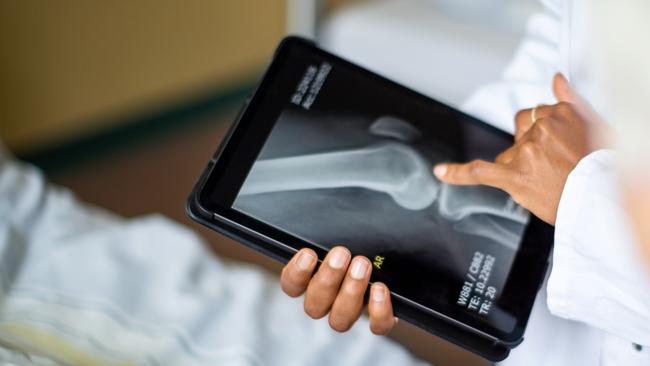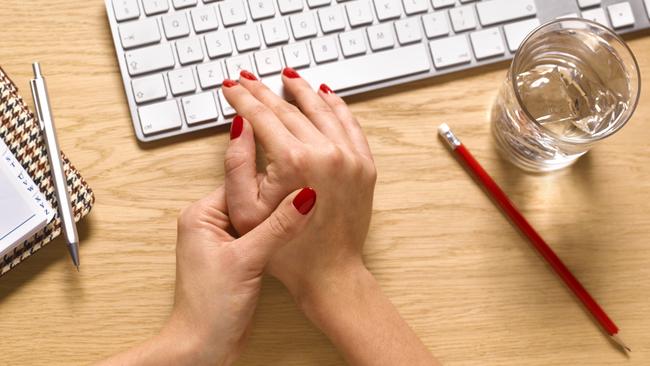I was diagnosed with arthritis at 29. These are the warning signs you may be missing
In my eagerness not to miss a workout or a night out socialising, there were red flags I ignored. Catching them early is key.

It all started with a swollen knee last March. It had been aching for a few days and one evening after a work event it became so sore that I couldn’t face the Tube home. I was 29, physically fit, with a strict (and intense) exercise routine, but I’d had a hectic few weeks. As I swung my legs out of the taxi I felt a sharp pain — my right knee was swollen, puffy and hot to touch. I’ve just overdone it a bit, I told myself. No need to panic.
Within a few days, I was panicking. I’d tried everything — ibuprofen, Deep Heat and ice packs — but my knee had ballooned. Stairs were an excruciating task and exercise was out of the question.
After a GP appointment and referral to hospital, I was sent for a series of blood tests, steroid injections, X-rays and an MRI. A month later, I got the diagnosis: rheumatoid arthritis.
I was shocked. I’d always associated arthritis with elderly people, not women in their twenties.
But there are other young sufferers like me. The World Health Organisation says that 45 per cent of people with rheumatoid arthritis are under 55. Last week it was reported that British media personality Coleen Rooney, 38, will get a sick note for some of the more strenuous bushtucker trials in this year’s I’m A Celebrity, Get Me Out of Here, which is being filmed in Queensland, due to her reactive arthritis.

Rheumatoid arthritis is a chronic, incurable auto-immune disease that mostly affects the joints, causing pain, swelling and stiffness. Unlike the wear-and-tear damage of osteoarthritis, which causes the cartilage between joints to break down, RA occurs when the immune system attacks the tissue surrounding the joints. I’m grateful I caught mine early; over time it can damage the lining of the joints, leading to erosion of cartilage and bone. RA can affect any joint in the body, but it’s most common in the small joints of the hands, wrists and feet. I’ve been lucky so far — aside from the occasional bit of stiffness in my fingers, the only real problem I’ve had is with my knee.
There are approximately 20 million people in the UK with arthritis, 450,000 of whom have rheumatoid, the second most common type after osteoarthritis, which affects ten million. The incidence of RA increases with age, with a peak onset at 30 to 50, and it is more common in women. Typically, but not exclusively, osteoarthritis affects over-50s.
Despite my disbelief at being diagnosed so young, I started to realise that there had been signs.
I’m hypermobile, meaning my joints move beyond most people’s range of motion, and my shoulders and wrists have always clicked in a way that made me wince.
Fatigue is a symptom too. Very rarely, after periods of intense exercise or late nights, I feel an indescribable tiredness where my whole body feels heavy. There have been many times when I’ve ignored it because I don’t want to skip a workout or miss out on socialising.
And stress can bring about a flare-up. During a relationship breakdown, I noticed there was a slight swelling in my knee. Later, my rheumatologist said it was an early sign of joint inflammation.
I rarely tell anyone about my condition: I hate for anyone to think of me as weak or incapable. If I’m in pain, I try my best to hide it, which compounds the problem. It’s the reason my knee swelled up in the first place.

The treatment for RA is relatively straightforward, for me at least, but it depends on the severity. Those who experience severe flare-ups may need regular steroid injections, but for me treatment is seven tablets of the immunosuppressant methotrexate on the same day each week. It helps to slow my overactive immune system and keep inflammation at bay. Thankfully I haven’t had any side affects, though others experience nausea and drowsiness. Anti-rheumatic drugs can affect your blood cells and liver, so I have to go for regular blood tests to monitor this. The drug also depletes your folic acid, so I take a supplements a few times per week and, if I ever want to have children, will have to pause medication.
To try to limit flare-ups, I’ve made lifestyle changes. I try to stick to a Mediterranean diet, eat whole foods and limit my alcohol intake. I avoid high-impact workouts which take a toll on my knees and instead focus on weight training and Pilates, which strengthen muscle around my joints. I still run, but only a few times a week and I keep to a 5km distance. I can still go on a long hike or ride a bike without fear.
When I first received my diagnosis I spent many sleepless nights googling the worst-case scenarios, but so far arthritis hasn’t turned out to be the debilitating condition I’d feared. At 31, I’m fitter and stronger than many people without arthritis. Just don’t sign me up for a bushtucker trial.
The Times



To join the conversation, please log in. Don't have an account? Register
Join the conversation, you are commenting as Logout